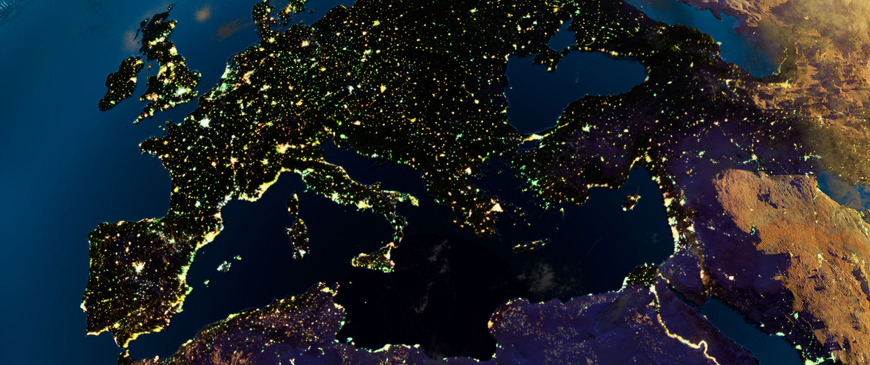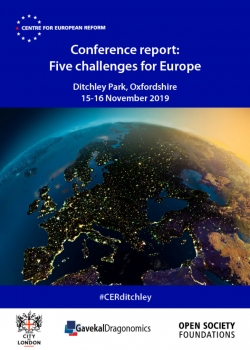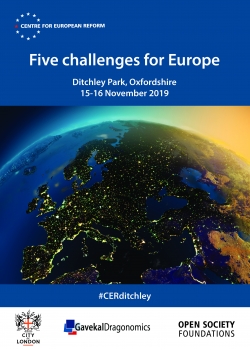
Conference report: Five challenges for Europe
Last week, The Economist journalist Duncan Robinson asked Twitter users their views on the biggest problems facing Europe. Many people replied with their pet peeves: “the rise of fascism”, “Brexit”, “Russian aggression”. But there are broader, structural shifts at work. In November, our annual economics conference focused on our choice of the five biggest problems facing Europe: an ageing society, growing competition between the US and China, gridlock over eurozone reform, climate change and regional inequality. Our view is that a stuttering European economy and regional divergence are big reasons for the continent’s political troubles, and in the next decade, rivalry between the US and China, climate change and ageing will force governments to make choices that will result in winners and losers.
At the conference, there were common threads in the debate on these apparently disparate subjects: how public investment, especially on curbing climate change, could balance the needs of an ageing society with the needs of young people and future generations; how to limit the damage from populism at home and abroad; and whether the EU should strengthen rules or have greater power to act strategically.
The way to fight Europe’s demographic challenges is to emphasise lifelong learning, find investments that benefit future generations and raise employment rates among older people.
The 50 leading economists at Ditchley agreed that Europe’s ageing society, which would have more over-65s than people of working age by around 2030, required people to work until later in life. There was a lot of scope for raising the employment rates of people in their 50s and 60s, as Sweden, the UK and Germany had done. State pension ages would have to rise. And governments would have to take more account of young people and future generations, with participants proposing higher public investment in training, education and climate and fiscal rules that took account of assets and liabilities (so that governments could raise debt if they invested in welfare-enhancing assets). Others suggested mandating paid leave from work for retraining, and giving qualifications a ‘best before’ date, after which more training was required.
Growing strategic competition between the US and China was largely seen by participants as a battle for technological superiority. The US aim was to try to prevent China from becoming rich, and to prevent Western technology from helping China to achieve parity with America. There was broad agreement that China had no interest in becoming a ‘Western’ liberal democracy or market economy. And Europe’s interests were changing: Northern Europe’s exports had been driven by Chinese demand for capital goods in recent years, but as Chinese technology improved, Beijing was increasingly a rival. Participants differed over what to do: for some, the EU should continue to try to agree rules with China to govern international trade and investment, and climate change. For others, the EU needed to provide alternative sources of funding for infrastructure investments in poorer member-states to stop China from undermining the bloc’s solidarity. Still others argued that the EU’s large market and sophisticated regulatory regime gave it power, and it should focus its attention on countries in its neighbourhood and elsewhere in Africa and Asia, offering market access in exchange for EU rules and standards.
China is not aiming to become a democracy or a market economy. To deal with it, the EU needs a new technology regime and to strengthen its own economy.
Participants were pessimistic that far-reaching eurozone reform would happen any time soon. While most agreed that greater risk-sharing between countries and co-ordinated fiscal policy were both needed, North-South divisions were too entrenched for the gridlock to end. One speaker said that in some ways the gridlock was consensual: governments could live with a fragile eurozone because reform would alienate too many voters. But there were some chinks of light: a German government paper on the banking union, published shortly before the conference, broke some taboos in the German debate, accepting the possibility of a common deposit insurance scheme alongside other measures to strengthen the eurozone’s banking system.
Adding to the gloom, most agreed that tackling climate change would require an unprecedented collective political effort: the investment needed to achieve a 2 degree rise in temperatures, let alone a 1.5 degree one, was enormous. There was praise for the EU for getting the Emissions Trading Scheme working again after a decade of under-pricing carbon, and Europe’s relative success in reducing emissions from electricity generation. But decarbonising transport, buildings and agriculture would be much harder, and many believed that it could only be done through a carbon tax that penalised all forms of emissions. Political consent could only be achieved if revenues from a carbon tax were distributed effectively. For some participants, the EU should impose penalties on carbon-intensive imports from the rest of the world, in order to sharpen incentives for other countries to take action.
Our last session, on regional divergence, offered some practical ideas on how to overcome the economic shifts that were favouring metropoles over peripheries. Improvements in information technology and the offshoring of manufacturing were drawing skilled workers and capital into the major cities, with post-industrial and remote areas struggling. Some of the needed reforms were unglamorous, with more investment in local transport in industrial areas to allow residents to get to city centres quickly and cheaply. Some member-states needed to strengthen security in certain regions, because investors were deterred by crime, and improve tax administration and the enforcement of contracts. And climate investment, if carefully managed, could offer a new source of middle-skill jobs in poorer areas.
Despite the serious problems that Europe faced, it was obvious that the only way they could be managed would be through collective action by the EU’s member-states – in close co-operation with its neighbouring countries and allies. While the EU had had a miserable decade, it remained the only tool to deal with the continent’s problems. A new generation of politicians, activists and thinkers was welcomed, as they pushed for a stronger and more strategic Union.




